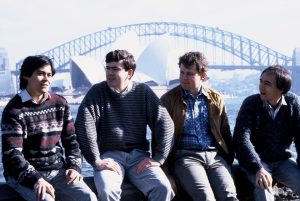
Micro Forté co-founder and CEO John De Margheriti reflects on how, when Micro Forté was established in the mids 1980s, despite the US ‘crash’, they looked to America.
They didn’t know of any other Australian games companies. They knew nothing of the UK games scene and the leading role that the Australian owned Melbourne House and their Melbourne-based development studio Beam Software had in that market. They did eventually learn about fellow Sydney developer Strategic Studies Group (SSG), but not at home.
John De Margherit explains:
“When we got started in 1985, they said that the industry was all over and we got in too late. I think Atari had gone under, and it was all doom and gloom and the industry was all over….we thought ‘Oh, we started into this game thing two years late, you know, it’s all over, it’s really sad. We missed the boat’.”
“America was the only market we knew. There was nothing going on [in the European market] If they did exist we didn’t know about it. It was actually really early days, so we didn’t sort of see Europe. We sort of saw America as the market, that our relation was very much an American relationship. We never really mixed it with the Brits…We eventually realised in 88 that we had missed that market completely.”
Unlike SSG, whose games were predominantly marketed to the more exclusive hobby of wargaming, Micro Forté was aiming for games’ mass audience, people who loved the arcades and wanted to game at home. They embraced the fun and challenges of popular arcade games. The arcade hit “Gauntlet“, for example, directly inspired Micro Forté’s “Demon Stalkers” (1987).
“We vaguely heard there was a company called Melbourne House but we didn’t know who they were and where was this house. We were 21, 22 years old, whatever we were. We didn’t understand much about the world and [only] vaguely knew about Melbourne, let alone a game developer there. We had no idea how big they were. We had heard about Strategic Studies Group (SSG) and we met them actually at the Computer Game Developers Conference in San Francisco, of all places. They were the only guys we had contact with and Roger Keating was the only game developer we knew well.”
“And when we discovered America, you know, Electronic Arts, then we got linkage to the American market and that is what we focused on. We knew there were British firms making games, but we didn’t really understand that and we saw everything from a very American world. The whole US scene had such a huge impact on us. It was professional and they were the world leaders and, you know, so we learnt from them on how to go about designing games and how to approach things professionally. In fact the two firms that taught us the most would probably be Electronic Arts and Microsoft. They’re two firms that were very polished and very professional how they went about things.”
References: Interview John De Margertiti, June 11 201Microforte
